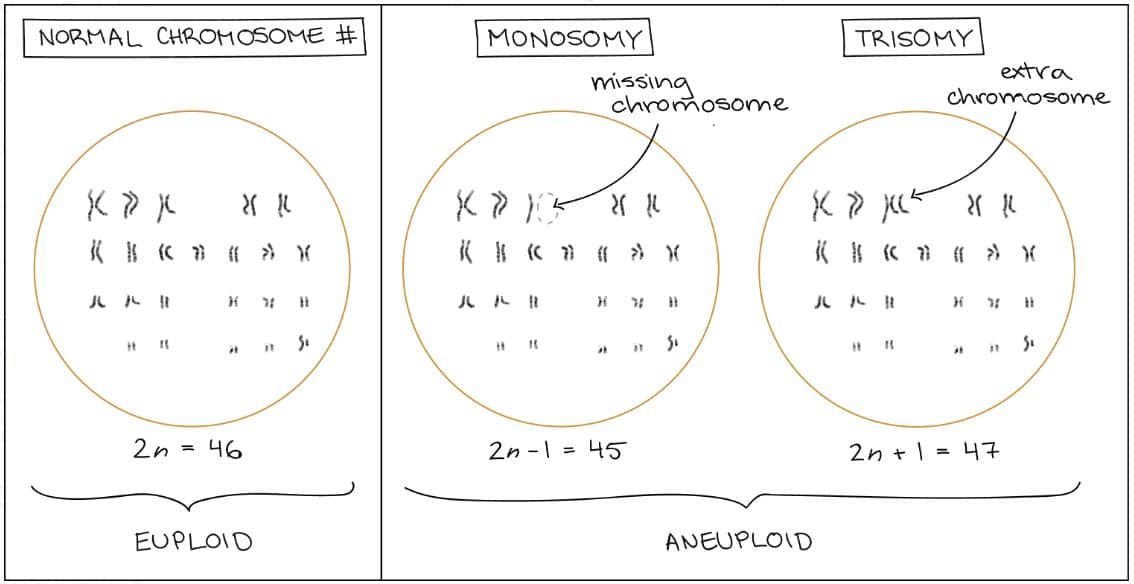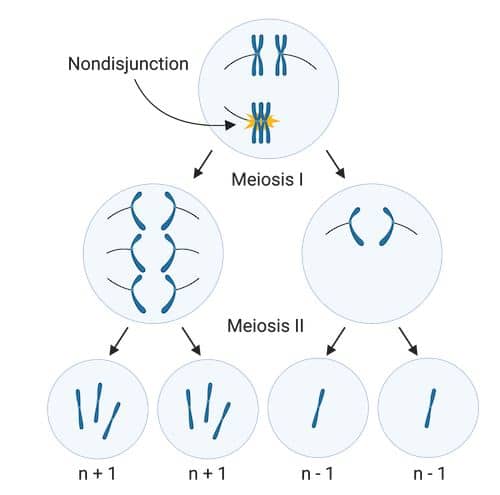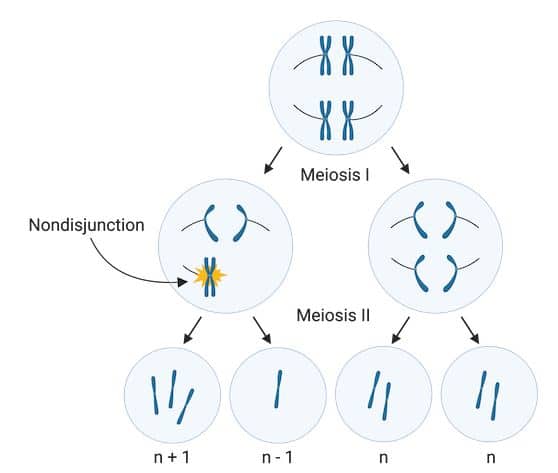Aneuploidy: Definition, Types and Disorders
Aneuploidy Definition
Changes in the genetic material of a cell are called mutations. During some types of mutations, cells end up with an extra or missing chromosome. This condition in which cells of a person have one or a few chromosomes below or above the normal chromosome number.is called as Aneuploidy. For example, three copies of chromosome21 are present in the case of Down syndrome, which is a form of aneuploidy.
Introduction: Each species has a characteristic chromosome number, such as 46 chromosomes for a typical cell in the human body. In organisms with two complete sets of chromosomes, like humans, this number is called 2n. When an organism or cell contains 2n chromosomes (or some other multiple of n), it is said to be euploid, meaning that it contains chromosomes correctly organized into complete sets (eu- = good).

If a cell is missing one or more chromosomes, it is said to be aneuploid (an- = no, “not good”). For example, human somatic cells with chromosome numbers of (2n-1 = 45) or (2n + 1 = 47) are aneuploid.
Similarly, a normal human egg or sperm has only one set of chromosomes (n = 23). An ovum or sperm with n-1= 22 or n + 1 = 24, is considered aneuploid.
Types of aneuploidy
Two common types of aneuploidy have their own special names.
-
Monosomy is a condition when an organism has only one chromosome instead of a normal complete homologous pair (two chromosomes). i.e 2n-1
-
Trisomy is a condition in which there are three copies of a particular chromosome, instead of the normal two (homologous pair). i.e. 2n+1
Aneuploidy also includes cases where a cell has a larger number of extra or missing chromosomes, such as (2n – 2), (2n + 2), (2n + 3).
| No. of Chromosome | Type | Karyotype and examples |
| 1 | Monosomy |
2n-1 = 45 in humans Turner syndrome XO
|
| 2 | Nullisomy |
2n-2
Not survive in diploids species.
Example is found in Hexaploid wheat
|
| 3 | Trisomy | 2n+1 = 47 in humans
Trisomy in Autosomes Down syndrome also called Trisomy 21 Edwards syndrome also called Trisomy 18 Patau syndrome also called Trisomy 13
Trisomy in Sex chromosomes Triple X syndrome, also called Trisomy X and 47,XXX Klinefelter syndrome (KS), also called 47, XXY XYY syndrome , male has an extra Y chromosome
|
| 4 | Tetrasomy
Rarely seen with autosomes
|
Tetrasomy X (also called XXXX syndrome, quadruple X, or 48,XXXX
XXYY syndrome 48,XXYY syndrome or 48,XXYY
|
| 5 | Pentasomy
Rarely seen with autosomes
|
Pentasomy X, also known as 49,XXXXX,
49,XXXXY syndrome XYYYY |
Causes of Aneuploidy
Chromosome number disorders are caused by non-disjunction of chromosomes, which occurs when pairs of homologous chromosomes or sister chromatids do not separate during meiosis I or II (or during mitosis).
Meiosis I. The following diagram shows how nondisjunction can occur during meiosis I if the homologous chromosomes do not separate. It results in the production of aneuploid sex cells or gametes (eggs or sperm).

Meiosis II. Nondisjunction may occur in meiosis II when sister chromatids (rather than homologous chromosomes) do not separate. Again, some gametes contain extra or missing chromosomes:

Mitosis. Nondisjunction can also occur during mitosis. In humans, chromosomal changes due to nondisjunction during mitosis in the cells of the body will not be passed on to the next progeny, because these cells do not produce sperm or eggs. But mitotic nondisjunction can cause other problems i.e. Cancer cells often have abnormal chromosome numbers.

When a sperm or aneuploid egg combines with a normal sperm or egg on fertilization, it forms a zygote that is also aneuploid. For example, if a sperm cell with an additional chromosome (n + 1) combines with a normal egg (n), the resulting zygote or single-celled embryo will have a chromosome number of 2n + 1.
Genetic disorders caused by Aneuploidy
Human embryos that are missing a copy of any autosome (nonsexual chromosome) do not develop at birth. In other words, human autosomal monosomies are always lethal. This is because embryos have too low a “dose” of proteins and other gene-encoded gene products on the missing chromosome.
Most autosomal trisomies also prevent an embryo from developing until birth. However, an additional copy of some of the smaller chromosomes (13, 15, 18, 21, or 22) may allow the affected person to survive for a short period after birth or, in some cases, for many years. When an additional chromosome is present, it can cause developmental problems due to an imbalance between the gene products of the duplicated chromosome and those of other chromosomes.
The most common trisomy among embryos that survive birth is Down syndrome or trisomy 21. People with this inherited disorder have short stature and digits, facial distinctions including a wide skull and large tongue, and developmental delays.
Here is a karyotype, or image of the chromosomes, of a person with Down syndrome. Most of the pairs of autosomes, and the X-Y pair of sex chromosomes, are normal. However, chromosome 21 is present in three copies.

Approximately 1 out of every 800 newborns are born with Down syndrome. However, the probability that a pregnancy will produce an embryo with Down syndrome increases with the age of a woman, particularly over 40 years. This is probably due to the more frequent nondisjunction in the developing eggs of older women.

Graph representing the increase in the frequency of Down syndrome with maternal age
Human genetic disorders can also be caused by aneuploidies involving sex chromosomes. These aneuploidies are better tolerated than autosomes because human cells have the ability to shut down additional X chromosomes in a process called X inactivation.
